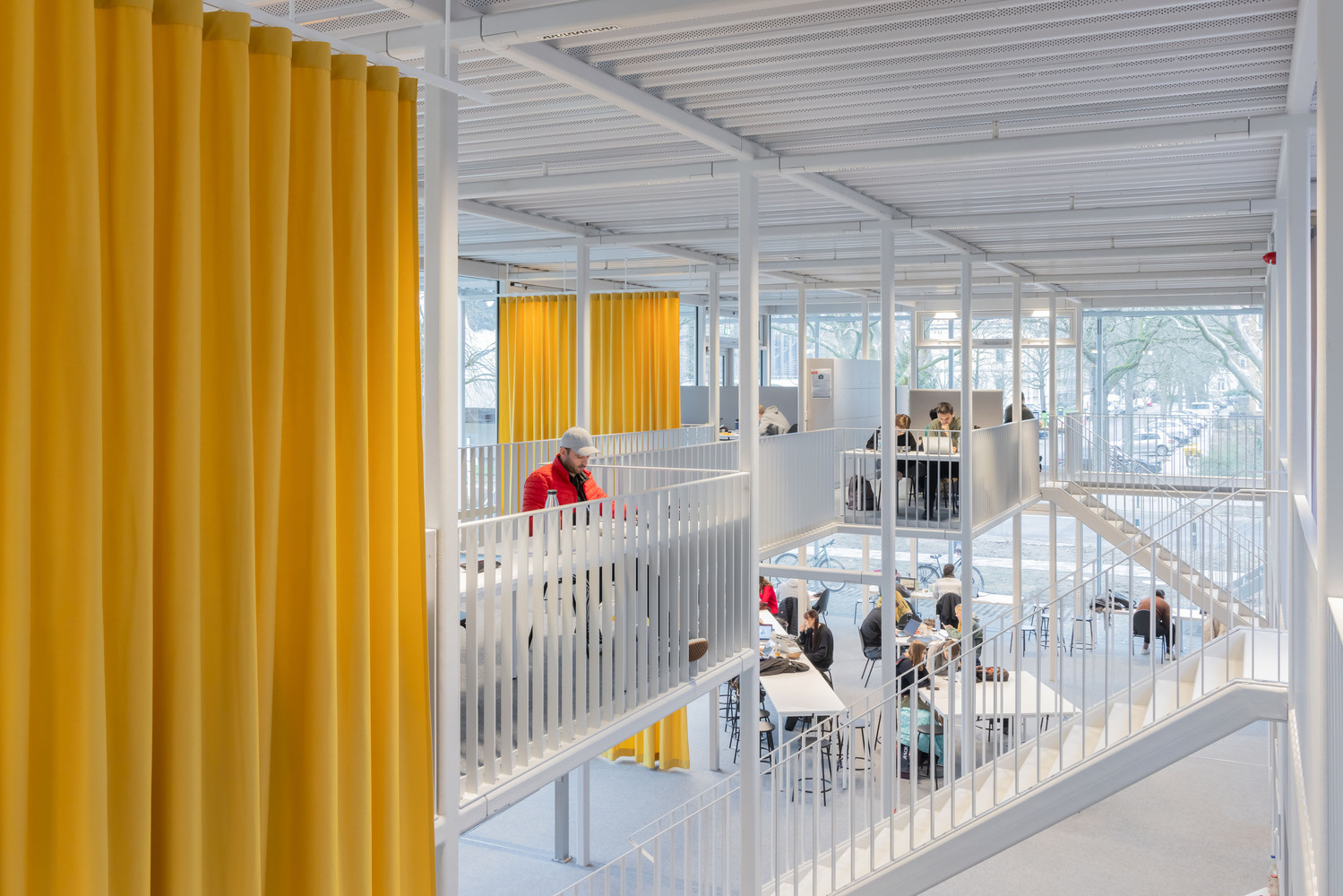
Gustav Düsing + Max Hacke-Study Pavilion TU Braunschweig
캠퍼스 중앙에 위치한 이 2층 건물은 새로운 랜드마크 역할을 한다. 열린공간으로 설계된 이 건물은 다양한 분야의 학생들을 수용할 수 있고 활동, 그룹작업, 세미나, 강의 및 휴식을 위한 유연한 시설을 제공한다. 이 건물의 디자인개념은 평평한 계층 구조로 학생과 교수진 간의 커뮤니케이션을 촉진하는 것이다. 일방적인 지식 전달을 강조하는 강의실 및 도서관 같은 전통적인 캠퍼스 유형과 달리 이 건물은 상호 작용을 장려한다.
내부를 자연 채광으로 가득 채우고 외부 공간과 매끄럽게 연결하는 유리 파사드가 특징이다. 어쿠스틱 커튼, 카펫 및 천장은 쾌적한 실내 사운드스케이프에 기여하여 대화 분위기를 조성한다. 캐노피와 발코니가 있는 3m 깊이의 아케이드는 여름에는 그늘을 제공하고 겨울에는 태양열을 획득하는데 이용된다. 또한 기울어진 창과 지붕의 돔을 통해 자연환기 된다.
The Study Pavilion at the Technical University of Braunschweig designed by Berlin based Architects Gustav Düsing & Max Hacke is an innovative campus building designed to cater the evolving academic landscape in a post pandemic world. With digital lectures and AI challenging traditional learning models, the role of the university campus is being reimagined.
Located on the central campus of the prestigious University the two story building serves as a new landmark, seamlessly integrating with existing pathways.
The primary objective was to create an accessible and versatile space that caters to students from all disciplines, offering a contemporary learning environment that complements existing campus typologies. The resulting open space concept fosters various student activities and provides a flexible setting for group work, seminars, lectures, and relaxation. A key design principle of the Study Pavilion is its flat spatial hierarchy, promoting interdisciplinary knowledge exchange and interpersonal communication among both students and faculty members.
Unlike traditional campus typologies like lecture halls and libraries that emphasize one sided knowledge transfer, this building encourages collaboration and interaction. It provides a foundation for all activities while granting students maximum freedom in its utilization.
To cultivate a sense of community that transcends individual subjects, the space was intentionally designed to be uniform, eliminating traffic areas and spatial divisions between floors. Instead, a series of zones were created, each with its own stairs and entrances. From spacious double height areas to cozy retreats and presentation spaces, the Study Pavilion offers a range of environments. Notably, the building features a fully glazed facade that floods the interior with natural light and seamlessly connects it with the exterior spaces. Acoustic curtains, carpeting, and ceilings contribute to a pleasant room soundscape, enabling conversational atmospheres.
The organizational principle of the building revolves around the concept of a superstructure, allowing for constant reconfiguration of the floor plan. This flexibility ensures the building remains relevant as a new campus element for an extended period.
The innovative steel wood hybrid construction is fully demountable, adhering to the "design for disassembly" principle. The modular primary support structure, composed of beams and columns on a 3x3m grid, allows for easy reconstruction or relocation. The concept aligns with the idea of a "future material depot," promoting circular building practices by reusing architectural elements like facade panels, stairs, and platforms.
Regarding energy efficiency, the Study Pavilion relies on a district heating supply sourced from 80% renewable energy, supplemented by ground probes for summer cooling. A 3m deep arcade with a canopy and balconies provides shade during summer while harnessing solar heat gain during the winter, this passive method is supported by the presence of up to 200 students working on laptops. The building is naturally ventilated through tilt windows and a central skylight dome.
Photography by Leonhard Clemens, Lemmart, Iwan Baan













from archdaily
